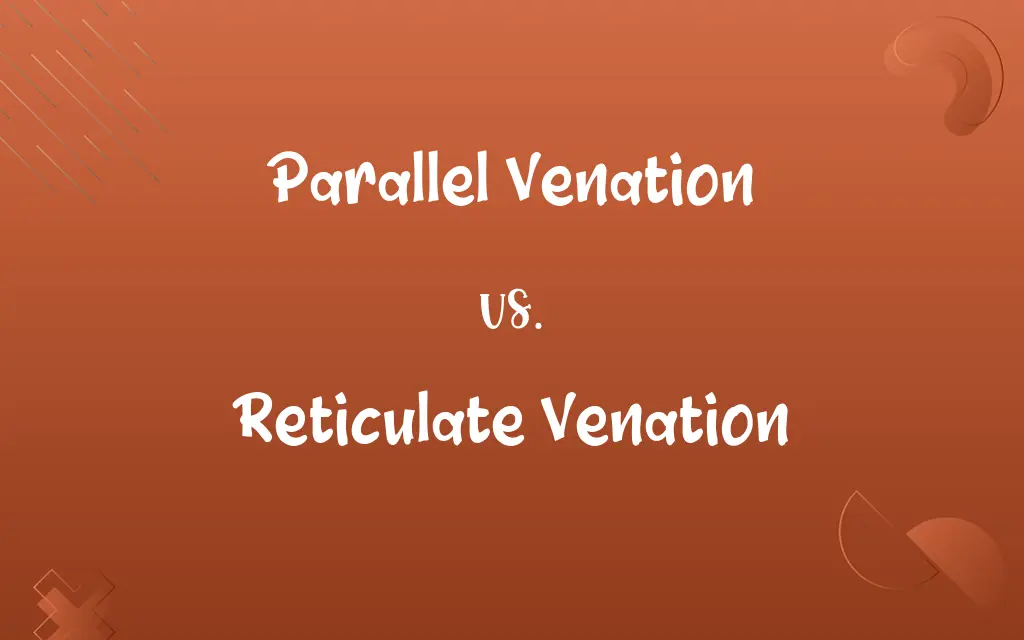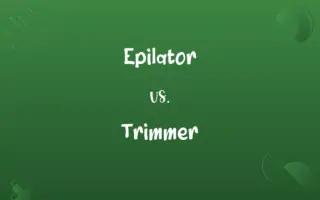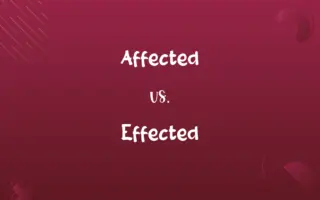Parallel Venation vs. Reticulate Venation: Know the Difference

By Shumaila Saeed || Published on February 17, 2024
Parallel venation has veins running side-by-side, common in monocots, while reticulate venation has a network-like pattern, typical in dicots.

Key Differences
Parallel venation is characterized by veins that run parallel to each other, often found in monocotyledonous (monocot) plants. Reticulate venation, on the other hand, displays a complex network of veins, typical in dicotyledonous (dicot) plants.
Shumaila Saeed
Feb 17, 2024
In parallel venation, the leaf veins are straight and parallel, creating a simpler pattern, common in grasses and grains. Reticulate venation shows interconnecting veins forming a net-like structure, seen in a wide variety of flowering plants like roses and oaks.
Shumaila Saeed
Feb 17, 2024
Parallel venation is an older evolutionary trait observed in simpler plants, while reticulate venation represents a more complex and advanced botanical structure. This complexity allows for more efficient nutrient and water distribution in the leaf.
Shumaila Saeed
Feb 17, 2024
Identifying parallel venation is straightforward due to its simple, linear pattern. Reticulate venation requires a closer look to appreciate the intricate network of smaller veins branching from the main ones.
Shumaila Saeed
Feb 17, 2024
Examples of plants with parallel venation include bamboo and lilies, which are often found in more water-abundant environments. Plants with reticulate venation, such as maples and daisies, are common in a variety of ecosystems, reflecting their complex leaf structure's adaptability.
Shumaila Saeed
Feb 17, 2024
ADVERTISEMENT
Comparison Chart
Typical Plant Type
Monocots (e.g., grasses, grains)
Dicots (e.g., flowering plants)
Shumaila Saeed
Feb 17, 2024
Evolutionary Trait
Older, seen in simpler plants
More advanced, seen in complex plants
Shumaila Saeed
Feb 17, 2024
ADVERTISEMENT
Parallel Venation and Reticulate Venation Definitions
Parallel Venation
A simple venation pattern common in monocotyledonous plants.
Grasses show parallel venation in their slender leaves.
Shumaila Saeed
Jan 12, 2024
Reticulate Venation
Intricate vein arrangement seen in broad, flat leaves.
Apple leaves exhibit a clearly visible reticulate venation.
Shumaila Saeed
Jan 12, 2024
Parallel Venation
Venation where veins run parallel to each other along the leaf.
The leaves of corn exhibit parallel venation.
Shumaila Saeed
Jan 12, 2024
Reticulate Venation
Network-like venation providing efficient nutrient distribution.
The reticulate venation in daisy leaves supports effective photosynthesis.
Shumaila Saeed
Jan 12, 2024
Parallel Venation
A linear vein arrangement, often in long, narrow leaves.
Bamboo leaves display a distinct parallel venation.
Shumaila Saeed
Jan 12, 2024
ADVERTISEMENT
Reticulate Venation
Venation forming a complex network of interconnecting veins.
The maple leaf's reticulate venation creates an intricate vein pattern.
Shumaila Saeed
Jan 12, 2024
Parallel Venation
Venation characterized by straight, unbranching veins.
The banana leaf's parallel venation is evident in its long, straight veins.
Shumaila Saeed
Jan 12, 2024
Reticulate Venation
Venation where smaller veins branch off from larger ones.
The oak leaf's reticulate venation includes fine veins branching extensively.
Shumaila Saeed
Jan 12, 2024
Parallel Venation
Venation typical in plants with a single embryonic leaf.
The parallel venation in lily leaves indicates their monocot nature.
Shumaila Saeed
Jan 12, 2024
Reticulate Venation
A characteristic vein pattern of dicotyledonous plants.
Roses, with their reticulate venation, show a complex leaf structure.
Shumaila Saeed
Jan 12, 2024
Repeatedly Asked Queries
What is reticulate venation?
A complex, network-like venation pattern, common in dicots.
Shumaila Saeed
Feb 17, 2024
Are there any dicots with parallel venation?
It's rare; most dicots exhibit reticulate venation.
Shumaila Saeed
Feb 17, 2024
What is parallel venation?
A venation pattern where veins run parallel to each other, typical in monocots.
Shumaila Saeed
Feb 17, 2024
Which plants typically have parallel venation?
Grasses, grains, and other monocotyledonous plants.
Shumaila Saeed
Feb 17, 2024
How does leaf shape correlate with venation type?
Parallel venation is often in narrow leaves, while reticulate is in broader leaves.
Shumaila Saeed
Feb 17, 2024
Can reticulate venation be found in monocots?
Generally, no. Monocots usually have parallel venation.
Shumaila Saeed
Feb 17, 2024
What is the significance of parallel venation in plants?
It's associated with the efficient transport of water and nutrients in monocots.
Shumaila Saeed
Feb 17, 2024
Is venation type important for plant identification?
Yes, it's a key characteristic in distinguishing between monocots and dicots.
Shumaila Saeed
Feb 17, 2024
Does reticulate venation offer any advantages?
Yes, it allows for more efficient photosynthesis and gas exchange in dicots.
Shumaila Saeed
Feb 17, 2024
How does venation affect a plant's growth?
It influences nutrient distribution, which impacts overall growth and health.
Shumaila Saeed
Feb 17, 2024
Can environmental factors influence venation patterns?
While genetics mainly determine venation, environment can slightly modify leaf structure.
Shumaila Saeed
Feb 17, 2024
Are there any exceptions to these venation rules?
Nature has variations, but these rules generally hold true for most plants.
Shumaila Saeed
Feb 17, 2024
How do venation patterns affect leaf strength?
Parallel venation often results in stronger leaves, while reticulate provides flexibility.
Shumaila Saeed
Feb 17, 2024
Do all plants have one of these two venation patterns?
Most plants fit into these categories, but there are always exceptions in nature.
Shumaila Saeed
Feb 17, 2024
Are venation patterns used in scientific classification?
Yes, they're an important characteristic in plant taxonomy.
Shumaila Saeed
Feb 17, 2024
Do venation patterns affect water usage in plants?
They can influence how efficiently a plant uses and distributes water.
Shumaila Saeed
Feb 17, 2024
Can venation type change with environmental stress?
The basic pattern won't change, but stress can affect leaf development.
Shumaila Saeed
Feb 17, 2024
Do parallel and reticulate venation affect leaf flexibility?
Yes, parallel venation can make leaves more rigid, while reticulate allows more flexibility.
Shumaila Saeed
Feb 17, 2024
Can venation patterns change over a plant's lifetime?
Generally, venation patterns are consistent throughout a plant's life.
Shumaila Saeed
Feb 17, 2024
Is venation visible in all leaves?
In most leaves, yes, but it can be more subtle in some species.
Shumaila Saeed
Feb 17, 2024
Share this page
Link for your blog / website
HTML
Link to share via messenger
About Author
Written by
Shumaila SaeedShumaila Saeed, an expert content creator with 6 years of experience, specializes in distilling complex topics into easily digestible comparisons, shining a light on the nuances that both inform and educate readers with clarity and accuracy.









































































